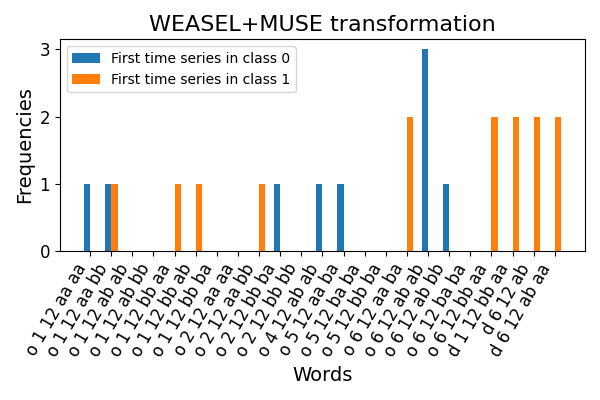Note
Click here to download the full example code
WEASEL+MUSE¶
WEASELMUSE stand for Word ExtrAction for time SEries cLassification plus
Multivariate Unsupervised Symbols and dErivatives.
This example shows how the WEASELMUSE algorithm transforms multivariate time
series of real numbers into a sequence of frequencies of words, and
illustrates the features obtained for two time series.
It is implemented as pyts.multivariate.transformation.WEASELMUSE.

# Author: Johann Faouzi <johann.faouzi@gmail.com>
# License: BSD-3-Clause
import numpy as np
import matplotlib.pyplot as plt
from pyts.datasets import load_basic_motions
from pyts.multivariate.transformation import WEASELMUSE
from sklearn.preprocessing import LabelEncoder
# Toy dataset
X_train, _, y_train, _ = load_basic_motions(return_X_y=True)
y_train = LabelEncoder().fit_transform(y_train)
# WEASEL+MUSE transformation
transformer = WEASELMUSE(word_size=2, n_bins=2, window_sizes=[12, 36],
chi2_threshold=15, sparse=False)
X_weasel = transformer.fit_transform(X_train, y_train)
# Visualize the transformation for the first time series
plt.figure(figsize=(6, 4))
vocabulary_length = len(transformer.vocabulary_)
width = 0.3
plt.bar(np.arange(vocabulary_length) - width / 2, X_weasel[y_train == 0][0],
width=width, label='First time series in class 0')
plt.bar(np.arange(vocabulary_length) + width / 2, X_weasel[y_train == 1][0],
width=width, label='First time series in class 1')
plt.xticks(np.arange(vocabulary_length),
np.vectorize(transformer.vocabulary_.get)(
np.arange(X_weasel[0].size)),
fontsize=12, rotation=60, ha='right')
y_max = np.max(np.concatenate([X_weasel[y_train == 0][0],
X_weasel[y_train == 1][0]]))
plt.yticks(np.arange(y_max + 1), fontsize=12)
plt.xlabel("Words", fontsize=14)
plt.ylabel("Frequencies", fontsize=14)
plt.title("WEASEL+MUSE transformation", fontsize=16)
plt.legend(loc='best', fontsize=10)
plt.subplots_adjust(bottom=0.27)
plt.tight_layout()
plt.show()
Total running time of the script: ( 0 minutes 1.274 seconds)

